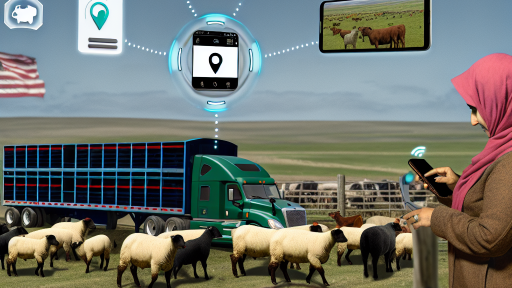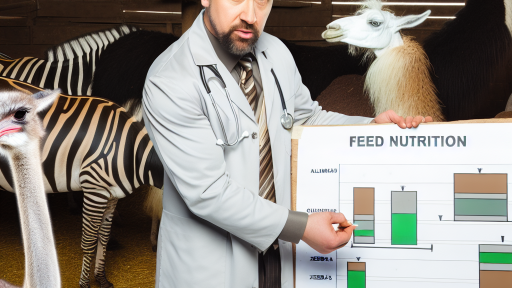Understanding the Different Modes of Livestock Transport
Overview of Livestock Transport Options
Livestock transport encompasses various methods to move animals from one location to another.
Farmers and livestock owners can choose from several transportation options.
Understanding these options helps ensure safe and efficient transport.
Road Transport
Road transport remains the most common method for livestock movement.
Trucks and trailers specifically designed for animals are widely used.
This method provides flexibility in routing and timing.
However, it requires careful planning to minimize stress on the animals.
Rail Transport
Rail transport offers a viable alternative for long-distance livestock movement.
Specialized rail cars ensure adequate space and ventilation for animals.
This method reduces the number of stops needed during transit.
In addition, rail is often more cost-effective for larger hauls.
Aerial Transport
Aerial transport is suitable for urgent or high-value livestock shipments.
This method guarantees speedy delivery to distant markets.
However, it is typically more expensive than other transport options.
Aerial transport also requires special handling procedures.
Transform Your Agribusiness
Unlock your farm's potential with expert advice tailored to your needs. Get actionable steps that drive real results.
Get StartedMaritime Transport
Maritime transport is used primarily for international livestock shipments.
Ships can carry large numbers of animals over long distances.
However, significant planning is crucial to ensure animal welfare during the voyage.
Regulations regarding animal transport vary by country and must be followed.
Choosing the Right Transport Method
Selecting the best transport option depends on various factors.
These factors include distance, animal welfare, and regulations.
Moreover, cost considerations play a significant role in decision-making.
Farmers should assess their specific needs and constraints.
Evaluating the Impact of Route Selection on Animal Welfare
Understanding Route Selection
Choosing the right route for livestock transport is crucial.
A well-planned route minimizes stress for the animals.
Furthermore, it enhances overall welfare during transit.
Factors Affecting Animal Welfare
Several factors influence animal welfare during transport.
First, consider the duration of the journey.
Long trips can increase stress levels significantly.
Next, evaluate the type of terrain.
Uneven or rough roads can cause discomfort and anxiety.
Environmental Conditions
Weather conditions play an important role in route selection.
High temperatures can lead to heat stress in animals.
Likewise, cold weather can cause health issues during transit.
Thus, selecting routes with favorable conditions is essential.
Regulatory Considerations
Legal regulations impact how livestock transport occurs.
Transporters must adhere to guidelines set by authorities.
These regulations often dictate maximum journey times.
Familiarizing oneself with these rules ensures compliance.
Showcase Your Farming Business
Publish your professional farming services profile on our blog for a one-time fee of $200 and reach a dedicated audience of farmers and agribusiness owners.
Publish Your ProfilePlanning for Animal Comfort
Choosing a route that allows for breaks is crucial.
Frequent stops enable animals to rest and hydrate.
Moreover, each stop provides an opportunity for assessment.
Transporters should monitor the health of animals regularly.
Choosing the Right Transport Vehicle
The vehicle used can also impact welfare during transport.
A proper vehicle provides adequate ventilation and space.
Features such as non-slip flooring reduce the risk of injury.
Prioritizing suitable vehicles enhances the transport experience.
Communication with Stakeholders
Open communication with all involved parties is vital.
Stakeholders include farmers, transporters, and destination facilities.
Timely updates on animal conditions can improve welfare measures.
Additionally, feedback from recipients can inform future routes.
Assessing and Adjusting Routes
Regularly assessing routes helps identify areas for improvement.
Analyze transport data to determine stress points.
Adjusting routes based on previous experiences is advantageous.
Ultimately, this leads to better animal welfare outcomes.
Key Factors to Consider When Choosing Transport Routes
Distance and Duration
Evaluate the total distance of the transport route.
Shorter distances typically mean less stress for the livestock.
Consider the estimated travel time as well.
Long travel times can lead to fatigue and discomfort for the animals.
Road Conditions
Assess the quality of roads along the intended route.
Potholes and rough terrain can increase the risk of injury.
Be mindful of the road surface material; unpaved roads may not be suitable.
Additionally, consider seasonal weather changes that may affect road conditions.
Traffic Patterns
Examine traffic volume during the planned transport times.
Heavy traffic can cause delays and increase stress on livestock.
Select routes that minimize interactions with high-density traffic areas.
Weather Conditions
Monitor the weather forecast before planning the route.
Extreme temperatures can be detrimental to animal welfare.
Avoid routes that expose livestock to extreme weather conditions.
Access to Emergency Services
Identify the proximity of emergency veterinary services along the route.
Having access to veterinarians can ensure immediate assistance if needed.
Plan routes that are near supportive facilities and possible resting points.
Legal and Regulatory Considerations
Understand the regulations associated with livestock transport in your area.
Familiarize yourself with any permits or documentation required.
Compliance with local laws can prevent unnecessary delays during transport.
Animal Welfare Standards
Prioritize routes that adhere to animal welfare guidelines.
Consider factors such as ventilation and space in the transport vehicle.
Ensure that the route allows for regular breaks and access to food and water.
See Related Content: Innovative Technologies Transforming Modern Aquaculture
Showcase Your Farming Business
Publish your professional farming services profile on our blog for a one-time fee of $200 and reach a dedicated audience of farmers and agribusiness owners.
Publish Your ProfileMapping Technology and Tools for Effective Route Planning
Importance of Route Planning
Effective route planning is crucial for livestock transport.
It ensures timely delivery to markets and farms.
Moreover, it minimizes stress on the animals during transit.
Utilizing GPS Technology
GPS technology enhances route accuracy in livestock transport.
This technology allows real-time navigation and tracking.
Subsequently, it helps in avoiding traffic jams and road closures.
Applications of GPS Devices
Many devices offer features tailored for livestock haulers.
For example, fleet management systems allow fleet oversight.
Furthermore, mobile apps provide instant route updates.
Leveraging Mapping Software
Numerous mapping software options assist in planning the best routes.
These tools offer insights on road conditions and distance.
Additionally, they include user-generated data for accuracy.
Features of Mapping Tools
- Traffic condition monitoring
- Route optimization algorithms
- Integration with weather data
Data Management Systems
Data management systems streamline logistics for livestock transport.
These systems track transportation schedules and animal health.
Furthermore, they facilitate communication between drivers and dispatchers.
Benefits of a Centralized System
A centralized data system improves efficiency in operations.
It assists in timely decision-making and route adjustments.
As a result, it can lead to reduced transportation costs.
Best Practices for Route Planning
Following best practices can enhance the safety of livestock transport.
Plan routes that have reliable road conditions.
Always consider rest stops for the animals along the way.
Considerations for Livestock Welfare
- Monitor temperature and weather conditions.
- Choose routes that avoid heavy traffic.
- Ensure access to veterinary care if needed.
See Related Content: Seasonal Care Tips for Sheep and Goats
Legal Regulations and Compliance in Livestock Transport
Understanding the Regulatory Framework
Livestock transport is governed by specific laws and regulations.
These regulations ensure the safety and welfare of animals during transit.
Furthermore, they promote public health and environmental standards.
Key Regulatory Bodies
Various organizations oversee livestock transport regulations.
The United States Department of Agriculture (USDA) plays a crucial role.
Additionally, the Animal and Plant Health Inspection Service (APHIS) has a significant impact.
Complying with Animal Welfare Standards
It is essential to adhere to animal welfare standards during transport.
Livestock must receive proper care, food, and water during transit.
Drivers need training in humane handling practices to minimize stress.
Route Planning and Compliance
Selecting routes requires careful consideration of legal requirements.
Some areas may have restrictions on livestock transport.
Be aware of any local ordinances that might affect your route.
Documentation Requirements
Accurate documentation is a must for legal compliance.
Transporters should maintain records of health certificates and permits.
Proper documentation ensures a seamless transit experience.
Consequences of Non-Compliance
Failing to comply with transport regulations can lead to severe penalties.
Fines and legal actions can disrupt operations and harm reputations.
Additionally, non-compliance can jeopardize the welfare of livestock.
Showcase Your Farming Business
Publish your professional farming services profile on our blog for a one-time fee of $200 and reach a dedicated audience of farmers and agribusiness owners.
Publish Your ProfileGain More Insights: Improving Livestock Productivity through Genetics

Assessing Seasonal Weather Conditions and Their Effects on Transport Routes
Understanding the Impact of Seasonal Variability
Seasonal weather changes significantly affect livestock transport routes.
Transport professionals must prepare for varying conditions throughout the year.
In summer, hotter temperatures can lead to heat stress in animals.
During winter, frost and ice can create dangerous driving conditions.
Identifying these seasonal variations will aid in route selection.
Evaluating Route Safety Based on Weather Conditions
Safety should always be a priority in livestock transport.
Weather forecasts provide essential information for planning routes.
Heavy rainfall can lead to road washouts and flooded areas.
High winds may create challenges for large transport vehicles.
Traveling during inclement weather increases risks for both animals and drivers.
Adjusting Transport Schedules to Mitigate Weather Effects
Flexibility in scheduling transport can enhance safety and efficiency.
Monitoring weather patterns allows for better timing of transport.
Transporting animals during milder weather can reduce stress levels.
Additionally, night travel in warmer months might help prevent overheating.
Strategic planning minimizes complications during adverse weather conditions.
Implementing Technology for Weather Tracking
Utilizing technology can significantly enhance route planning.
Real-time weather apps provide valuable updates for transporters.
Drones may assist in assessing road conditions before travel.
GPS systems can suggest alternative routes based on weather data.
Integrating technology improves the overall livestock transport process.
Communicating with Stakeholders about Weather Challenges
Effective communication with all parties is crucial during transport.
Transporters should inform farmers about potential delays due to weather.
Drivers must report any hazardous conditions encountered on the route.
Maintaining clear communication enhances trust and reduces anxiety.
Collaborative efforts contribute to smoother transport operations.
Explore Further: Genetic Tools for Enhancing Dairy Production
Logistics and Coordination with Transport Companies
The Importance of Coordination
Efficient coordination is vital for successful livestock transport.
It ensures the animals’ safety and overall well-being during transit.
Proper planning minimizes delays and logistical challenges.
Effective communication with transport companies is necessary.
Choosing the Right Transport Company
Select a transport company that specializes in livestock transport.
Experience with livestock ensures they understand specific needs.
Review their reputation and track record in the industry.
Obtain references from other livestock producers.
Planning the Route
Evaluate possible routes for efficiency and safety.
Consider factors like road conditions and travel times.
Look for routes that minimize stress for the animals.
Identify rest stops along the way for breaks.
Compliance with Regulations
Understand the regulations governing livestock transport in your area.
Showcase Your Farming Business
Publish your professional farming services profile on our blog for a one-time fee of $200 and reach a dedicated audience of farmers and agribusiness owners.
Publish Your ProfileEnsure that the transport company complies with all legal requirements.
Document all necessary permits and health certificates.
Stay informed about changing regulations that may affect transport.
Monitoring and Feedback
Monitor the transport process closely to identify any issues.
Collect feedback from the transport company regarding the process.
Use this information for future improvements.
Regularly reassess the relationship with the transport provider.
Case Studies: Successful Livestock Transport Route Planning
Innovative Solutions from Cattle Transport
Green Pastures Logistics utilized cutting-edge route planning technology.
This company categorized routes based on real-time traffic data.
Additionally, they incorporated weather forecasts to avoid delays.
As a result, their journey times decreased by 20% overall.
They also reported lower stress levels in the transported cattle.
Efficiency in Sheep Transport
Horizon Transport faced challenges with long delivery times.
They re-evaluated their routes by studying past performance data.
Subsequently, they implemented an optimized scheduling system.
This change resulted in reduced fuel costs by 15%.
Moreover, they improved compliance with animal welfare standards.
Case of Poultry Deliveries
Sunny Farms Poultry adopted a data-driven approach for transport.
They collected feedback from drivers to enhance their routes.
This feedback highlighted frequently congested areas.
After adjustments, they minimized delays significantly.
Their delivery accuracy improved, boosting customer satisfaction.
Lessons Learned and Applied Innovations
Each case emphasizes the importance of real-time information.
Data analytics play a crucial role in successful route planning.
Additionally, collaboration with drivers yields valuable insights.
Ultimately, these strategies lead to safer and more efficient transport.
Livestock welfare and satisfaction of stakeholders should remain priorities.
Additional Resources
Executive Summary – Wildlife-Vehicle Collision Reduction Study …
AVMA Guidelines for the Euthanasia of Animals: 2020 Edition*




